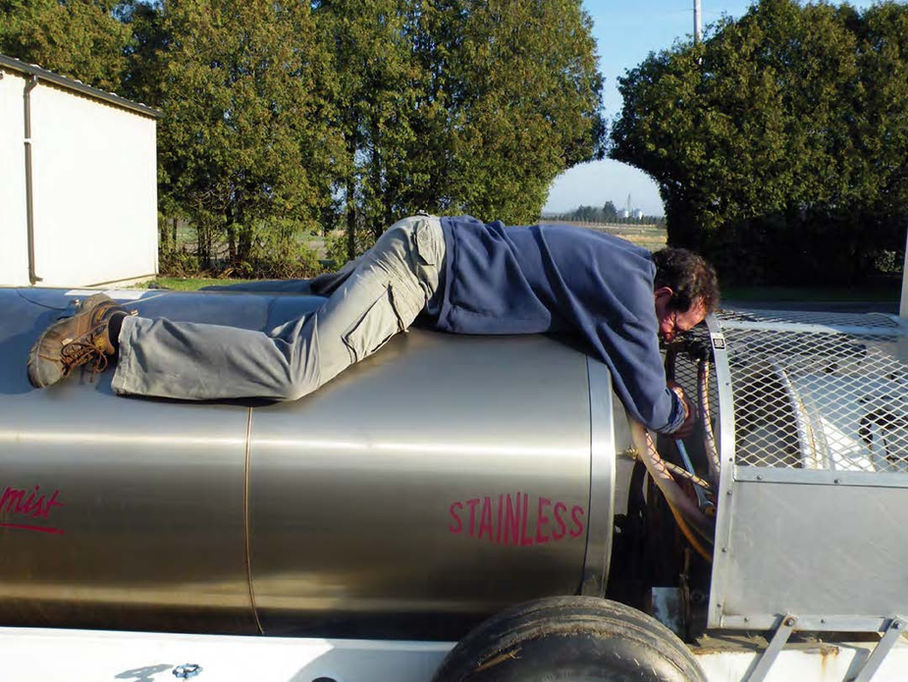When it’s time to spray your fruit and nut crop or tree farm, you can’t afford downtime. Every minute counts. That’s why it’s important to properly maintain the spraying system for your orchard, grove or nursery on a regular basis. No matter what type of agriculture spraying system you use, proper maintenance is crucial to ensure that your system will be in good working order when it’s time to spray.
Let’s take a look at conventional air blast sprayers, ultrasonic sprayers and density-based agriculture spraying systems and how they stack up in terms of maintenance.
1. Conventional air blast sprayers
- Spray nozzles. Because conventional spraying systems are either on or off, they spray constantly, which results in wear and tear on the nozzles and erosion of the holes over time, so check them regularly. Regular inspections of the spray nozzles are essential to avoid unexpected failure at a critical time in spraying.
- Calibration. The proper nozzle size and pressure is essential to developing the optimal droplet size and intended spray pattern. With conventional air blast sprayers, calibrations must be performed for each different crop or block because using the same settings for crops of varying densities can result in over or under-spraying of your orchard, grove or nursery. Once you have determined the calibrations for various crops or blocks, you should record them for future use.
- Additional maintenance considerations. Clogged or worn spray nozzles are the leading culprit in improper spraying with air blast sprayers. While the system will continue to spray, it’s entirely possible that the application rate differs significantly from your original calibrations. Regular flow checks and catch tests should be conducted. You’ll also need to regularly test and inspect your pressure gauge and sprayer output to ensure that they’re still operating at the optimal settings.
2. Ultrasonic sprayers
- Spray nozzles. Ultrasonic spraying systems sense the presence of trees and turn the spray nozzles on whenever trees are detected. They do not control flow through the nozzles; they merely direct them to turn on or off. With more “off” time than a conventional sprayer, the nozzles may last longer. However, spray nozzles should be maintained in the same way as conventional air blast sprayers. They must be soaked and cleaned on a regular basis to avoid a distorted spray pattern, change in spray output or changes in droplet size.
- Calibration. Proper calibration is also essential for ultrasonic spraying systems. The best way to test the application rate is to do a “paper test”, in which you place a piece of water-sensitive paper in different areas of a tree and check that each area has received equal spray. If the papers aren’t evenly soaked, the likely causes are either: 1) You’re operating your sprayer at a rate of speed that’s too high for the sensors to work properly, or 2) The switch on your unit isn’t working properly.
- Valves. Ultrasonic spraying systems typically utilize ball valves to turn the spray nozzles on and off. They must be regularly cleaned and checked for leaks and corrosion and to ensure that they are shutting off properly and at the same speed.
- Lenses. One of the biggest maintenance considerations with ultrasonic sprayers is the lenses. There are multiple lenses that become dirty with use and need regular cleaning, sometimes even during the course of a spray application, to continue to function properly. Failure to keep the lenses clean throughout your application can result in overspraying or sprayer failure.
3. Density-based sprayer*
- Spray nozzles. Density-based spraying systems utilize LiDAR technology, which uses light in the form of a pulsed laser that senses not only the presence of trees, but the density of the tree canopy. The LiDAR then sends a signal to individual solenoid valves that manage the rate of application in each individual nozzle. Because density-based spraying systems control the flow through the nozzles, there is much less wear and tear on the nozzles. (Note: Nozzles should still be regularly maintained as clogged screens will affect the nozzles’ ability to spray at the proper PSI.)
- Calibration. During the set-up and calibration process, the system determines algorithms for calculating spray volume based on crop density and location. Once these settings have been determined, the system manages the spray application automatically. The control system will alert the operator to any issues with spray nozzles or application rates.
- Solenoid valves. When working properly, solenoid valves should turn on and off approximately 10 times per second. Visually inspect the valves to ensure that they’re all firing properly to ensure the correct application rate.
- Lens. The density-based spraying system has a single, well-protected lens, and filtered air is blown over the lens to create a pressure barrier to help keep it clean. At times when the lens becomes dirty (such as when the system is not in use), it’s easy to clean. The control system also creates a warning on the tablet to make the operator aware of the need to clean the lenses.
*At the time of this post, the Smart Apply Intelligent Sprayer™ is the only density-based sprayer available on the market; therefore, the density-based spray system features in our comparison all pertain to the Intelligent Sprayer.
The bottom line
Air blast sprayers have been the work horses of agriculture spraying systems for years. While they have a reputation for being low maintenance, they’re not maintenance-free or hassle-free. Without proper attention, they still continue to spray, but the intended levels of spray application may be significantly off from the original calibrations.
Both ultrasonic and density-based spraying systems have specialized components, such as ball valves or solenoids, that require a little extra attention. However, for many farmers, the chemical cost savings, particularly for the density-based sprayer, more than makes up for the additional maintenance of these special components that enhance spraying precision. For more comparisons of conventional, ultrasonic and density based sprayers, check out this blog post.
Learn more about the Smart Apply Intelligent Sprayer:
Based in Indianapolis, Indiana, Smart Apply, Inc. manufactures the Smart Apply® Intelligent Sprayer™, the only density-based, intelligent spray system available on the market today. At Smart-Apply, we’re committed to helping tree and nut growers and nursery owners across the United States and around the world realize chemical cost savings, improved sustainability through healthier trees and plants, cleaner and safer groundwater and greater overall yields, with an easy-to-use, reliable system based on years of research and cutting-edge technology.
Learn more about the Smart Apply Intelligent Sprayer™:
- Visit SmartApply.com to get more information or request a demo.
- Call: 317.222.4152 to talk to a Smart Apply expert today.
If you’d like to partner with a company that’s revolutionizing agriculture spraying systems and get ahead of the curve, join the Smart Apply team today.

